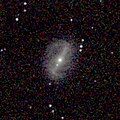NGC 6217
| NGC 6217 | |
|---|---|
 NGC 6217 сфотографирован космическим телескопом Хаббла | |
| Observation data (J2000 epoch) | |
| Constellation | Ursa Minor |
| Right ascension | 16h 32m 39.217s[1] |
| Declination | +78° 11′ 53.56″[1] |
| Redshift | 0.004543 ± 0.000013[2] |
| Heliocentric radial velocity | 1,368[3] km/s |
| Distance | 67.2 Mly (20.6 Mpc)[3] |
| Apparent magnitude (V) | 11.2[4] |
| Characteristics | |
| Type | (R)SB(rs)bc[5] |
| Apparent size (V) | 55,000 light years |
| Other designations | |
| ARP 185, UGC 10470[2][6] | |
NGC 6217 - это запертая спиральная галактика, расположенная около 67 миллионов световых лет , до конца, [ 3 ] В созвездии минор Урса . 10 см (4 дюйма) или более крупным Он может быть расположен с телескопом объектом 11-й величины примерно на 2,5 ° к востоку-северо-востоку от звездного Zeta Ursae Lineris . [ 4 ] Галактика наклоняется углом 33 ° к линии обзора вдоль угла положения 162 °. [ 3 ]
Морфологическая классификация (R ') SB (RS) BC [ 5 ] Указывает, что NGC 6217 имеет ложную внешнюю кольцевую структуру, образованную из спиральных рук (R '), четко определенной полосы, проходящей через ядро (SB), частичное внутреннее кольцо (RS) и умеренно насыщенные спиральные рычаги ( до н.э. [ 7 ] Ядро имеет сферическую форму, не показывая указания на развязь . [ 5 ] Выдающийся стержень охватывает угловое расстояние 48 ″ (48 секунды дуги ) через галактику вдоль угла положения 35,97 ° ± 0,35 °. В 10 ″ к юго -востоку от ядра находится видная область звездного образования. Внутреннее кольцо составляет около 43 дюймов. [ 8 ]
NGC 6217 has been characterized as a starburst galaxy, which means it is undergoing a high rate of star formation compared to a typical galaxy. As a result, the spectrum is dominated by stellar photoionization from young, hot stars.[9] This component is less than 10 million years old, producing a blue-hued spectral continuum with absorption weak lines from elements other than hydrogen and helium.[6] At the core of the galaxy is a low-luminosity active galactic nucleus which has formed an H II region.[10]
One supernova has been observed in NGC 6217: SN 2018gj (type II, mag 14.4).[11]
Gallery
[edit]References
[edit]- ^ Jump up to: a b Skrutskie, Michael F.; Cutri, Roc M.; Stiening, Rae; Weinberg, Martin D.; Schneider, Stephen E.; Carpenter, John M.; Beichman, Charles A.; Capps, Richard W.; Chester, Thomas; Elias, Jonathan H.; Huchra, John P.; Liebert, James W.; Lonsdale, Carol J.; Monet, David G.; Price, Stephan; Seitzer, Patrick; Jarrett, Thomas H.; Kirkpatrick, J. Davy; Gizis, John E.; Howard, Elizabeth V.; Evans, Tracey E.; Fowler, John W.; Fullmer, Linda; Hurt, Robert L.; Light, Robert M.; Kopan, Eugene L.; Marsh, Kenneth A.; McCallon, Howard L.; Tam, Robert; Van Dyk, Schuyler D.; Wheelock, Sherry L. (1 February 2006). "The Two Micron All Sky Survey (2MASS)". The Astronomical Journal. 131 (2): 1163–1183. Bibcode:2006AJ....131.1163S. doi:10.1086/498708. ISSN 0004-6256. S2CID 18913331.
- ^ Jump up to: a b "NGC 6216", NASA/IPAC Extragalactic Database, retrieved 2013-06-20.
- ^ Jump up to: a b c d Gusev, A. S.; et al. (August 2012), "Oxygen and nitrogen abundances of H II regions in six spiral galaxies", Monthly Notices of the Royal Astronomical Society, 424 (3): 1930–1940, arXiv:1205.3910, Bibcode:2012MNRAS.424.1930G, doi:10.1111/j.1365-2966.2012.21322.x, S2CID 118437910.
- ^ Jump up to: a b O'Meara, Stephen James (2007), Steve O'Meara's Herschel 400 Observing Guide, Cambridge University Press, p. 227, ISBN 978-0521858939.
- ^ Jump up to: a b c Ann, Hong Bae (December 2003), "CCD Surface Photometry of Spiral Galaxies: Bulge Morphology", Journal of the Korean Astronomical Society, 36 (4): 261–270, Bibcode:2003JKAS...36..261A, doi:10.5303/jkas.2003.36.4.261.
- ^ Jump up to: a b Cid Fernandes, Roberto; González Delgado, Rosa M.; Schmitt, Henrique; Storchi-Bergmann, Thaisa; Martins, Lucimara P.; Pérez, Enrique; Heckman, Timothy; Leitherer, Claus; Schaerer, Daniel (April 2004), "The Stellar Populations of Low-Luminosity Active Galactic Nuclei. I. Ground-based Observations", Astrophysical Journal, 605 (1): 105–126, arXiv:astro-ph/0401416, Bibcode:2004ApJ...605..105C, doi:10.1086/382217, S2CID 119101213.
- ^ Buta, Ronald J.; et al. (2007), Atlas of Galaxies, Cambridge University Press, pp. 13–17, ISBN 978-0521820486.
- ^ Cabrera-Lavers, A.; Garzón, F. (March 2004), "An Optical Study of a Sample of Spiral Galaxies", The Astronomical Journal, 127 (3): 1386–1404, Bibcode:2004AJ....127.1386C, doi:10.1086/381924.
- ^ Elfhag, T.; et al. (February 1996), "A CO survey of galaxies with the SEST and the 20-m Onsala telescope", Astronomy and Astrophysics Supplement, 115: 439–468, Bibcode:1996A&AS..115..439E.
- ^ Véron-Cetty, M.-P.; Véron, P. (July 2010), "A catalogue of quasars and active nuclei", Astronomy and Astrophysics, 518 (13th ed.): A10, Bibcode:2010A&A...518A..10V, doi:10.1051/0004-6361/201014188.
- ^ Переходные именные записи сервера для SN 2018GJ. Получено 5 января 2023 года.
Внешние ссылки
[ редактировать ] СМИ, связанные с NGC 6217 в Wikimedia Commons
СМИ, связанные с NGC 6217 в Wikimedia Commons - «Хаббл открывает новые глаза на вселенную» , Новостной центр сайта Хаббл , НАСА, 9 сентября 2009 г. , Получено 2013-06-18
- "NGC 6217" . Симбад . Страсбургский астрономический центр обработки данных . Получено 2013-06-20 .

